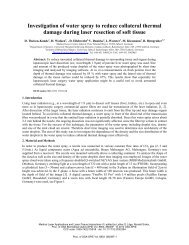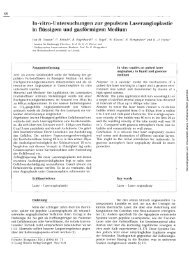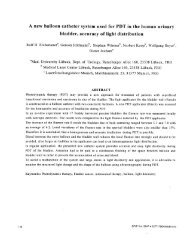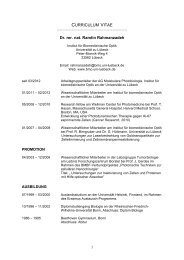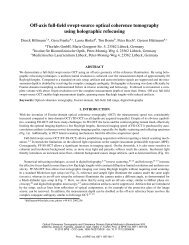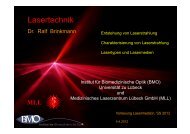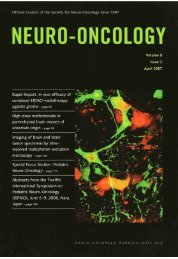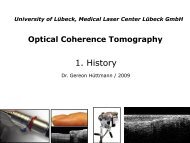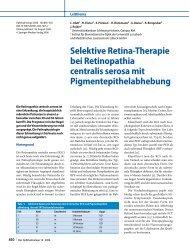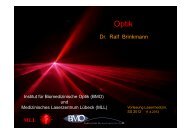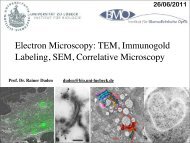Invited p aper Mechanisms of femtosecond laser nanosurgery of ...
Invited p aper Mechanisms of femtosecond laser nanosurgery of ...
Invited p aper Mechanisms of femtosecond laser nanosurgery of ...
You also want an ePaper? Increase the reach of your titles
YUMPU automatically turns print PDFs into web optimized ePapers that Google loves.
VOGEL et al. <strong>Mechanisms</strong> <strong>of</strong> <strong>femtosecond</strong> <strong>laser</strong> <strong>nanosurgery</strong> <strong>of</strong> cells and tissues 1041ond or microsecond range [57, 213]. The bubble-nucleationthreshold by thermolysis <strong>of</strong> strongly absorbing biomoleculessuch as melanin was found to be about 150 ◦ C for pulse durationsbetween 12 ns and 1.8 µs [208]. This seems to be thelower temperature limit <strong>of</strong> cell surgery using microsecondpulses. The upper limit <strong>of</strong> a localized temperature rise withoutbubble formation is given by the threshold for explosive vaporizationin the entire focal volume that for non-pigmentedcells was found to be about 220 ◦ C [213]. This thresholdis lower than the superheat limit <strong>of</strong> water at ambient pressure(≈ 300 ◦ C) above which homogeneous nucleation andspinodal decomposition will result in a phase explosion [2,159, 163], probably because <strong>of</strong> the heterogeneous structure <strong>of</strong>the cells.The temperatures required for quasi-cw cell surgery areconsiderably higher than those involved in <strong>femtosecond</strong> <strong>laser</strong>dissection by high-repetition-rate fs pulse trains that relies onphotochemical and free-electron-mediated chemical effects(Sect. 7.1). They are in a similar range as the temperaturesneeded for <strong>femtosecond</strong> <strong>laser</strong> surgery at repetition rates below1MHzthat is based on bubble formation by tensile thermoelasticstress (Sect. 7.2).The spatial resolution <strong>of</strong> quasi-cw cell surgery is relatedto the temperature distribution arising from a continuous deposition<strong>of</strong> <strong>laser</strong> energy via linear absorption that was presentedin Fig. 11. Interestingly, it is not much broader than thetemperature distribution arising from nonlinear absorption <strong>of</strong><strong>femtosecond</strong> pulse trains shown in Fig. 10. However, as thespatial resolution <strong>of</strong> <strong>femtosecond</strong> <strong>laser</strong> surgery is given by thewidth <strong>of</strong> the free-electron distribution rather than by the temperaturedistribution, the precision <strong>of</strong> the energy depositionin fs <strong>laser</strong> surgery is considerably better than for cw or longpulsedirradiation. The half-width <strong>of</strong> the free-electron distributionshown in Fig. 8b for λ = 800 nm and NA = 1.3 is only190 nm in the radial direction, compared to the half-widths <strong>of</strong>590 nm and 730 nm <strong>of</strong> the temperature distributions in Fig. 11resulting from irradiation with pulse durations <strong>of</strong> 10 µs and10 ms, respectively. It should be mentioned, however, thatthermal damage is not directly proportional to the temperatureelevation but to the damage integral that is an exponentialfunction <strong>of</strong> temperature [212]. The thermally damaged regioncan therefore be narrower than the half-width <strong>of</strong> the temperaturedistribution [42, 214]. Because <strong>of</strong> this reason, the gain <strong>of</strong>spatial resolution achievable by use <strong>of</strong> ultra-short <strong>laser</strong> pulsesinstead <strong>of</strong> quasi-cw irradiation is less than <strong>of</strong>ten assumed.Using fs pulses, extracellular chromosomes could be completelydissected with an FWHM cut size <strong>of</strong> about 300 nm,which amounts to 40% <strong>of</strong> the diffraction-limited focal spotsize [37]. Berns et al. produced chromosomal lesions <strong>of</strong> lessthan 1-µm size using argon-<strong>laser</strong> irradiation [34]. Thus, thespatial resolution achieved by IR <strong>femtosecond</strong> <strong>laser</strong> surgeryis a factor <strong>of</strong> about three better than that <strong>of</strong> the classical techniqueintroduced more than 30 years ago [69].A major advantage <strong>of</strong> <strong>femtosecond</strong> <strong>laser</strong> surgery is thatit can be performed at arbitrary locations even in media thatare transparent at low irradiances, and with much less averagepower. The use <strong>of</strong> low-power argon <strong>laser</strong>s requires staining<strong>of</strong> the target structures [34, 47, 52, 69]. The need for stainingreduces the versatility <strong>of</strong> the technique compared to <strong>femtosecond</strong><strong>laser</strong> surgery that can be performed at any arbitrarylocation. Another important advantage <strong>of</strong> ultra-short <strong>laser</strong> irradiationis the option to combine material modification withhigh-resolution nonlinear imaging modalities.Recently, Paterson et al. reported that cell-wall permeabilizationis possible with a low-power blue diode <strong>laser</strong>(λ = 405 nm) using0.3-mW irradiation and 40-ms exposuretime [56]. Owing to the short <strong>laser</strong> wavelength, the energyused (13 µJ) was three orders <strong>of</strong> magnitude less than the energyrequired for membrane permeabilization with 488-nmirradiation [52]. It was more than one order <strong>of</strong> magnitudelarger than the energy <strong>of</strong> 0.5 µJ needed with ns pulses [48],but the transfection process with millisecond pulses avoidsmechanical disruptions extending beyond the region <strong>of</strong> the<strong>laser</strong> focus that are a problem with ns pulses [3]. Mechanicaldisruption was also avoided in the study by Tirlapur andKönig who used 80-MHz <strong>femtosecond</strong> pulse trains <strong>of</strong> 800 nmfor membrane permeabilization [53], but the total energy employedwas here about 50 times larger than with the blue diode<strong>laser</strong>. Considering the fact that a blue <strong>laser</strong> diode is less costlythan a <strong>femtosecond</strong> <strong>laser</strong>, the practical advantages <strong>of</strong> ultrashort<strong>laser</strong> pulses for membrane permeabilization still haveto be proven. However, ultra-short <strong>laser</strong> pulses are the tool<strong>of</strong> choice for intracellular and intratissue <strong>nanosurgery</strong> at arbitrarylocations and/or in conjunction with nonlinear imaging.7.4 Potential hazards from low-density plasmasin multiphoton microscopyand second-harmonic imagingA matter <strong>of</strong> concern is that low-density plasmascould be a potential hazard in multiphoton microscopy [203,210, 215–217] and higher-harmonic imaging [86, 218–221].Multiphoton imaging <strong>of</strong> cells is usually done using <strong>femtosecond</strong><strong>laser</strong> pulses <strong>of</strong> about 700–1100-nm wavelength emitted at≈ 80 MHz from an oscillator with mean powers <strong>of</strong> 100 µW upto several milliwatts [210, 211]. Similar mean powers are requiredfor second-harmonic imaging [220]. These <strong>laser</strong> powersare close to the threshold for cell damage reported to bebetween 2mW and 10 mW depending on the damage criterionused, the pulse duration, and the number <strong>of</strong> appliedpulses [4, 82, 98, 144, 202, 203]. They are also close to thevalues used for intracellular and intratissue dissection thatrange from 4 to 100 mW, depending on target structure [4,53, 55, 77, 86, 88]. This suggests that the mechanisms underlying<strong>laser</strong> cell surgery may also contribute to the side effectsin nonlinear imaging.Our results indicate that thermal damage can be ruledout as a cause <strong>of</strong> cell damage in multiphoton microscopy aseven dissection with oscillator pulses does not involve thermaleffects (Fig. 21), and previous studies confirm this finding[222, 223]. In the literature, photodamage produced byshort <strong>laser</strong> pulses is mostly ascribed to multiphoton-inducedphotochemistry [72, 82, 224]. However, a comparison <strong>of</strong> theirradiance thresholds for photodamage with the correspondingfree-electron densities in Fig. 21 shows that the formation<strong>of</strong> low-density plasmas may contribute considerably tothe observed damage or even dominate its creation, especiallyin non-stained targets. An exception is the work <strong>of</strong>Berns et al. [224], who achieved gene manipulation by exposingchromosomes that were sensitized with a dye absorbing



